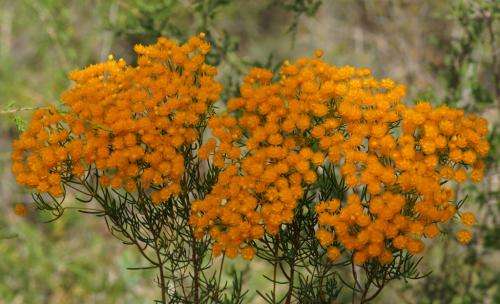South-west plants share fungal symbiosis for nitrogen uptake

An investigation into nitrogen transfers between plants has found that different species can share nutrients through fungal interactions.
The study looked into numerous nutrient-acquisition strategies of plants to determine if nitrogen transfers between native plants exist in nutrient-poor soils in south-west Australia.
We've had this question [of] how is it possible that our ecosystem has so many species when the soils are so poor?" co-author Professor Erik Veneklaas says.
"What we've shown here is that it is the balance between positive and negative interactions that could help species survive together and in a way collaborate whilst they also compete."
Lead author and UWA's François Teste and his team found that plant species connected by both arbuscular mycorrhizal (AM) and ectomycorrhizal (EM) fungal interactions benefitted most from nitrogen transfer between plants.
AM interactions penetrate plant roots allowing nutrient intake, whilst EM interactions form sheaths around the roots of plants rather then infiltrating them.
"My work highlights that these interactions might also be partly responsible for biodiversity; so nutrient retention and sharing can be part of the reason why so many species are interacting together," Dr Teste says.
Nitrogen is an essential nutrient for plants as it is a basic component of chlorophyll that is used to process sunlight into energy through photosynthesis.
It also increases the strength and support of roots, allowing plants to take in more water and nutrients.
The transfer of nitrogen in various chemical forms between the atmosphere, the earth, plants and mammals is the nitrogen cycle and is essential for all forms of life.
Findings lend support for restoration efforts
The findings highlight the importance of plant diversity in ecosystems with Dr Teste hoping for improvements to restoration efforts.
"What I would wish is that in terms of restoration hopefully my work can highlight that assemblages and interactions are also part of the equation to successfully restoring areas that are having a hard time," Dr Teste says.
The exploration of fungal interactions between plants adds to prior knowledge of plants receiving and donating nitrogen through root transfers in addition to nitrogen obtained from the atmosphere as a result of post-lightning rain and nitrogen fixing bacteria.
Dr Teste and Professor Veneklaas are two of four WA scientists who conducted the study, the others being Professor Kingsley Dixon and Professor Hans Lambers.
More information: "Is nitrogen transfer among plants enhanced by contrasting nutrient-acquisition strategies?" Teste FP, Veneklaas EJ, Dixon KW, Lambers H. Plant Cell Environ. 2014 May 8. DOI: 10.1111/pce.12367. [Epub ahead of print]
Journal information: Plant Cell
Provided by Science Network WA
















